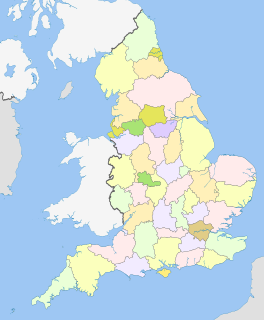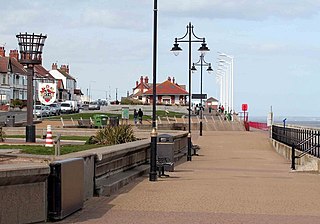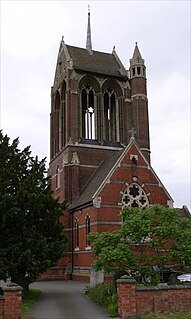
A county is a geographical region of a country used for administrative or other purposes in certain modern nations. The term is derived from the Old French conté or cunté denoting a jurisdiction under the sovereignty of a count (earl) or a viscount. Literal equivalents in other languages, derived from the equivalent of "count", are now seldom used officially, including comté, contea, contado, comtat, condado, Grafschaft, graafschap, and zhupa in Slavic languages; terms equivalent to English language administrative terms like municipality, district, circuit and commune/community are now often instead used.

In the United Kingdom, a scheduled monument is a nationally important archaeological site or historic building, given protection against unauthorised change.

Historic Scotland was an executive agency of the Scottish Office and later the Scottish Government from 1991 to 2015, responsible for safeguarding Scotland's built heritage, and promoting its understanding and enjoyment. Under the terms of a Bill of the Scottish Parliament published on 3 March 2014, Historic Scotland was dissolved and its functions were transferred to Historic Environment Scotland (HES) on 1 October 2015. HES also took over the functions of the Royal Commission on the Ancient and Historical Monuments of Scotland.

New College is one of the constituent colleges of the University of Oxford in the United Kingdom. Founded in 1379 by William of Wykeham, the full name of the college is The College of St Mary of Winchester in Oxford. The name "New College", however, soon came to be used following its completion in 1386 to distinguish it from the older existing college of St Mary, now known as Oriel College.

A listed building, or listed structure, is one that has been placed on one of the four statutory lists maintained by Historic England in England, Historic Environment Scotland in Scotland, Cadw in Wales, and the Northern Ireland Environment Agency in Northern Ireland.

The historic counties of England are areas that were established for administration by the Normans, in many cases based on earlier kingdoms and shires created by the Anglo-Saxons and others. They are alternatively known as ancient counties, traditional counties, former counties or simply as counties. In the centuries that followed their establishment, as well as their administrative function, the counties also helped define local culture and identity. This role continued even after the counties ceased to be used for administration after the creation of administrative counties in 1889, which were themselves amended by further local government reforms in the years following.

Cumberland is a historic county of North West England that had an administrative function from the 12th century until 1974. It was bordered by Northumberland to the northeast, County Durham to the east, Westmorland to the southeast, Lancashire to the south, and the Scottish counties of Dumfriesshire and Roxburghshire to the north. It formed an administrative county from 1889 to 1974 and now forms part of Cumbria.
A census-designated place (CDP) is a concentration of population defined by the United States Census Bureau for statistical purposes only. CDPs have been used in each decennial census since 1980 as the counterparts of incorporated places, such as self-governing cities, towns, and villages, for the purposes of gathering and correlating statistical data. CDPs are populated areas that generally include one officially designated but currently unincorporated community, for which the CDP is named, plus surrounding inhabited countryside of varying dimensions and, occasionally, other, smaller unincorporated communities as well. CDPs include small rural communities, colonias located along the Mexico–United States border, and unincorporated resort and retirement communities and their environs.

The historic counties of Wales are sub-divisions of Wales. They were used for various functions for several hundred years, but for administrative purposes have been superseded by contemporary sub-national divisions, some of which bear some limited similarity to the historic entities in name and extent. They are alternatively known as ancient counties.

The counties of England are areas used for different purposes, which include administrative, geographical, cultural and political demarcation. The term 'county' is defined in several ways and can apply to similar or the same areas used by each of these demarcation structures. These different types of county each have a more formal name but are commonly referred to just as 'counties'. The current arrangement is the result of incremental reform.

For local government purposes, Scotland is divided into 32 areas designated as "council areas", which are all governed by single-tier authorities designated as "councils". They have the option under the Local Government (Scotland) Act 1997 of being known as a "comhairle" when opting for a Gaelic name; only Comhairle nan Eilean Siar has chosen this option, whereas the Highland Council has adopted its Gaelic form alongside its English equivalent informally.

Hornsea is a seaside town and civil parish in the East Riding of Yorkshire, England. The settlement dates to at least the early medieval period. The town was expanded in the Victorian era with the coming of the Hull and Hornsea Railway in 1864.
Images of England is an online photographic record of all the listed buildings in England at the date of February 2002. The archive gives access to over 323,000 colour images, each of which is matched with the item's listed designation architectural description.

Inter-county cricket matches are known to have been played since the early 18th century, involving teams that are representative of the historic counties of England and Wales. Since the late 19th century, there have been two county championship competitions played at different levels: the County Championship, a first-class competition which currently involves eighteen first-class county clubs among which seventeen are English and one is from Wales; and the Minor Counties Championship, which currently involves nineteen English county clubs and one club that represents several Welsh counties.

The counties of the United Kingdom are subnational divisions of the United Kingdom, used for the purposes of administrative, geographical and political demarcation. The older term, shire is historically equivalent to county. By the Middle Ages, county had become established as the unit of local government, at least in England. By the early 17th century, all of England, Wales, Scotland, and Ireland had been separated into counties. In Scotland shire was the only term used until after the Act of Union 1707.

A redundant church is a church building that is no longer used for Christian worship. The term most frequently refers to former Anglican churches in the United Kingdom, but may also be used for disused churches in other countries.

Milecastle 73 (Dykesfield) was one of a series of Milecastles or small fortlets built at intervals of approximately one Roman mile along Hadrian's Wall.

The Court House, sometimes known as the Old Town Hall, is a 19th-century building in St Albans, Hertfordshire, England. It no longer serves a judicial function. In 2018 the local museum, which had been closed for some years, was rehoused in the building.














